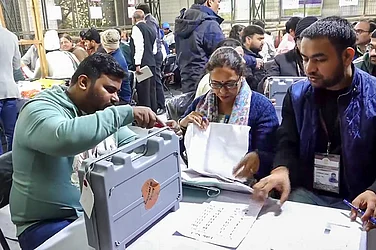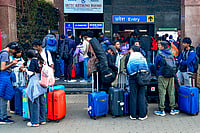"Death is an intellectual matter, but dying is pure pain."
—John Steinbeck
And the pain doesn’t get worse than when a hangman tightens his noose, no matter how hardened a criminal you are. It’s a fate that awaits nine inmates at Delhi’s Tihar Jail. However much they start philosophising about life after death, nothing prepares those on Death Row to give up life. Till it becomes inevitable, each man here lives in the fond hope that reprieve might come from some quarter—a pardon from the President, mercy from the court he's gone to in appeal. If not the mortals, God perhaps; most convicts turn to prayer on days they can't cope.
Till the other day, they were ten men on Death Row. Then the Delhi High Court commuted to life the death sentence of one, Mohammad Sheikh Noor Hussain, convicted for the rape and murder of his three-year-old daughter. But not before Hussain had spent an agonising four years waiting to die.
It's late Tuesday morning when I'm allowed access to the cells where those condemned to die must live till death—or mercy. It's a dark, dingy walk down the row of cells, each no more than 8 ft x 10 ft. Enough to squeeze in a concrete bed—6 ft x 3 ft—and a commode. As Death Row inmate, you're allowed a sheet and blanket, but not a pillow. The cells are neater than I expect; the inmates apparently sweep themselves. A tiny slit on one side of the wall—which some call a window, others a ventilator—ensures "free flow of air". An overhead fan and a naked light bulb complete the starkness of the surroundings.
Inside the cell, it could be any time of the day, or week, or year. Life on Death Row is a seemingly endless wait till the day your call comes to walk to the gallows. Only, the last time such a call came in at Tihar was in 1989.
"Each one of them wants to prolong the process for as long as he can. It's almost as if he'd give anything to live for another month, another year," says a jailor. Ask Devender Pal Singh Bhullar. He's been here for the last five years. A Sikh militant convicted for the Youth Congress HQ attack in Delhi in '93, which left nine dead and cost then Youth Congress president Maninderjit Singh Bitta his leg, his mercy petition has been pending with the President since '03.
Despair, mostly, is what all convicts walk in with. The latest to enter Death Row is Santosh K. Singh, sentenced to death for the rape and murder of Priyadarshini Mattoo. He went through an initial phase of depression, but, as a jailor reveals, "seems to have gotten over it and thinks there is still hope for him". So, he spends time reading law books, preparing for his appeal against the death sentence in the Supreme Court. "It'll take some time for it to sink in," says the jailor. "Some time to accept that he could be locked up for years and years."
Life on Death Row is a lonely, depressing interlude. The prisoners are kept in isolation, though the jailors prefer to call it segregation. Segregation is described as living alone in a small cell, under round-the-clock surveillance, and being allowed to have only a few meals with general prisoners, that too in the presence of guards. This treatment is for high-security prisoners, "in cases where other prisoners may be endangered in any manner," says an official.
One Death Row convict, however, has managed to charm jailors and escape his segregation. That's Sushil Sharma, convicted for killing wife Naina Sahni and trying to burn pieces of her body in the tandoor of a Connaught Place hotel. He has been allotted a normal cell which he shares with two other prisoners. There he spends most of his time in puja, and cutting and pasting pictures of gods and goddesses all over his cell. "The death sentence has made him extremely philosophical," says a jailor. "He talks about things like the futility of life, and death being just an interim phase till rebirth."
But even in segregation, prisoners can read, write, subscribe to papers and magazines, ask relatives to bring books, and food. They can also spend up to Rs 500 a week on canteen food, sweets and soft drinks. Bhullar, for instance, takes a break from the regular jail food and has an occasional chhole-bhature from the canteen. Mostly, the food has to be eaten before the guards, but should the inmates want to take it to their cell, it has to be in special unabrasive utensils.
Bhullar also spends his time reading the Guru Granth Sahib or the religious literature Christian organisations send him. The 40-year-old former professor of economics also subscribes to Punjabi dailies, including Charhdikala, Ajit and Punjabi Tribune. He gets mail from Canada and from Sikhs in other parts of the world. Quite a few of his visitors too are from Canada and from the Gurudwara Prabandhak Committee.
Is all this of any solace to Afzal, recently sentenced to death in the Parliament attack case and whose mercy petition is now pending with the President? The heckling by other prisoners despite being in segregation agitated him initially but he's now learning to take things in his stride. He writes a lot of letters and is regularly visited by his wife and relatives. He also gets a lot of visitors from NGOs and the legal fraternity. "He observed the Ramzan fasts and reads namaaz diligently five times a day," says his jailor. "And now that he knows he might be in jail for long, he has started requesting for books, mostly literary and motivational books in Urdu. One book he read was Islami Riasat, another was Quran Wa Hadith Ke Khazane. He also asked a visiting International Committee for Red Cross team for Kashmir-related books."
Like Afzal, Red Fort attack convict Mohammad Arif too likes to read Islamic texts. Besides, the Pak national and LeT militant is into body-building, using just about anything around, even bricks, as weights. It is not unusual to see him doing push-ups or sit-ups during free time every morning and evening.
However, fellow national Mohammad Hussain, lodged in the same jail, prefers to stay aloof. Convicted for planting explosives on a Blueline bus in Delhi in December '97 that killed four passengers and injured 24, he doesn't interact with any prisoner even if given a chance.
But however resigned to their fate they become, the despair of the condemned hits you on a visit to Death Row. While general prisoners laugh, joke and seem cheerful in their cells, gloom's writ large on the faces and environs on Death Row. Says psychologist Dr Rajat Mitra, who has interacted with inmates here, "They're all lonely people. Lonely by nature, not because of incarceration. They have mostly never had a support structure of a loving family and lived by their own rules." This helps them believe they did what they did for a cause and have no reason to repent. Martyrdom dulls the edge of the death blow, as long as the world knows they walked bravely to the gallows.
But till that final call does come, each man on Death Row wants to live just another day. So strong in fact is this desire to live that they would rather hang in jail forever rather than have death take them away.






















